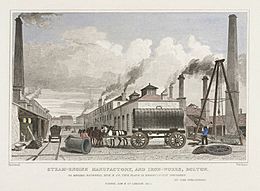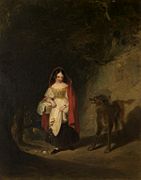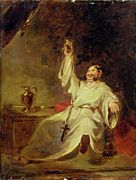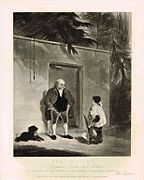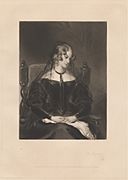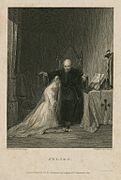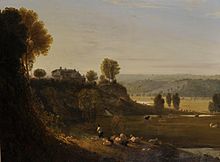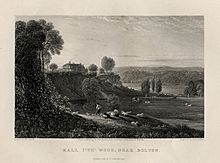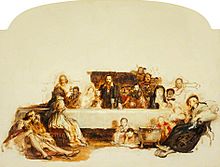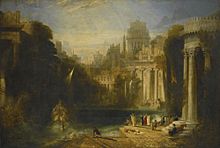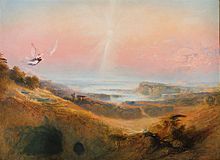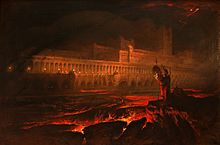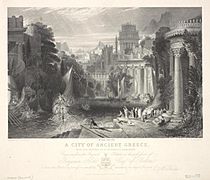Benjamin Hick facts for kids
Quick facts for kids
Benjamin Hick
|
|
|---|---|
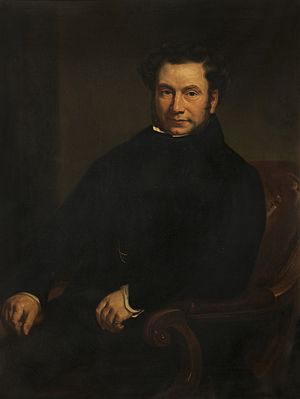
c.1840 by George Patten ARA (1801–1865)
|
|
| Born | 1 August 1790 Huddersfield, Yorkshire, England
|
| Died | 9 September 1842 (aged 52) Bolton, Lancashire, England
|
| Nationality | British |
| Occupation | Civil and Mechanical engineer Architectural designer Company director |
| Known for | Steam engines Locomotives Architecture Art Collector |
|
Notable work
|
3-cylinder locomotive Aerodynamic disc wheel Hydraulic press Radial Drilling machine 2-cylinder beam engine |
Benjamin Hick (born August 1, 1790 – died September 9, 1842) was a talented English engineer and art collector. He made important improvements to steam engines and invented useful scientific tools. Many of his ideas helped the engineering world, even though he didn't always patent them or get credit.
Contents
Early Life and Engineering Start
Benjamin Hick was born in Huddersfield, England. His family soon moved to Leeds, where he went to school.
When he was 14, in 1804, Benjamin started an apprenticeship as a draughtsman. He worked at the Round Foundry in Holbeck for a company called Fenton, Murray and Wood. This company built steam engines and machines for making textiles. Benjamin was so good that he was trusted to install large steam engines. He was even offered a partnership when his training ended.
However, Benjamin decided to move to Bolton in 1810. There, he became the manager of Rothwell's Union Foundry for Smalley, Thwaites and Company.
Community Involvement and New Ideas
In 1820, Benjamin Hick joined other important business leaders to create the Bolton Gaslight and Coke Company. This company provided gas for lighting public buildings, street lamps, and factories.
Benjamin was also a member of the "prosecution" club, which helped inventor Samuel Crompton get a regular payment for his work. In 1824, Benjamin joined the Institution of Civil Engineers, a group for professional engineers.
Benjamin Hick was a key supporter of the Bolton and Leigh Railway. This railway opened on August 1, 1828. He and his business partner, Peter Rothwell, even welcomed Robert Peel, who was then the home secretary, to their foundry.
Later, in 1837, Benjamin was part of the committee for the Bolton and Preston Railway. By 1841, he was the Deputy Chairman and a Director of this railway. The Hick and Hargreaves families were connected by marriage in 1836.
Benjamin Hick was known for using high-pressure and compound steam engines in textile mills. These engines were considered the best at the time. Locomotives built by Hick's company were also very high quality.
Rothwell, Hick and Rothwell Company
By 1821, Benjamin Hick was the managing partner of the Union Foundry. This company later became known as Rothwell, Hick and Rothwell. They made steam engines, hydraulic presses, weighing machines, and other factory equipment. They also built fireproof buildings.
After Peter Rothwell passed away in 1824, the company continued as Rothwell, Hick & Co. with Peter Rothwell Jr. They kept making stationary steam engines and other engineering products, including cast iron dockyard cranes.
In 1824, a clever Swiss engineer named Johann Georg Bodmer worked with Rothwell, Hick and Rothwell. He used their workshops to develop his textile machinery. They even worked on a huge waterwheel at Egerton Mill, which was 62 feet tall! This waterwheel became a popular place for tourists to visit in the 1830s and 1840s.
Benjamin Hick also became close friends with engineer and artist James Nasmyth. Nasmyth described Hick as an "admirable man" who was very skilled in engineering. Hick invented a special self-tightening collar used in hydraulic presses.
Hick and Rothwell built their first locomotive, named Union, in 1830. They also built locomotives for railways in America, like Pioneer for the Petersburg Railroad and the Pontchartrain for the Pontchartrain Railroad in New Orleans.
Designing Buildings and Public Works
Benjamin Hick was also a talented draughtsman and designer. He was asked to design several public buildings in Bolton. These included the Dispensary (1825) and the Gas Works.
Some of his designs, like the Little Bolton Town Hall (1826) and the Waterworks cottage (1824) in Belmont, can still be seen today. He also designed a special Gas Pillar for the opening of Bolton's New Market Place in 1826. This pillar was described as "elegant and classical workmanship."
B. Hick and Sons Company
In 1814, Benjamin Hick married Elizabeth Routledge. She was the sister of his friend and fellow engineer, Joshua Routledge. Benjamin had five children. He trained his two sons, John (1815–1894) and Benjamin (1818–1845), to be engineers.
On April 10, 1833, Benjamin and his sons started their own factory called B. Hick and Sons. It was located at the Soho Foundry in Bolton. Their company built the locomotive Soho for the Bolton and Leigh Railway. Soon, they became well-known suppliers to railway companies in Britain and other countries.
Three years later, Benjamin's oldest daughter, Mary (1813–1878), married John Hargreaves Jr, who operated the Bolton & Leigh and Leigh & Kenyon Junction railways.
After Elizabeth passed away, Benjamin married Hannah Elizabeth Goodyer in 1827. His family also had connections to famous people like W. S. Gilbert of Gilbert and Sullivan.
Supporting the Arts
Benjamin Hick was a serious collector and patron of the arts. This means he bought many artworks and supported artists. He was one of many wealthy business owners in the North of England who collected art in the mid-1800s.
He was known for his "acknowledged taste and judgment" in art. His private collection, built over 30 years, was "valuable, well known and much admired." It included works by Italian, Flemish, Dutch, and British Masters. He was very generous in supporting British artists and was friends with many of them.
Benjamin Hick collected antiques, bronze sculptures, engravings, marbles, paintings, and watercolor drawings. He owned works by famous artists like Canaletto, Peter Paul Rubens, and David Wilkie.
He had a great respect for art and books. Benjamin Hick wanted to create a Public Picture Gallery in Bolton. He believed that such a gallery would help "improve the taste and cultivate the better feeling of the rising generation." He even got designs for this project, but he passed away before he could make it happen.
Collection
-
Little Red Riding Hood by Henry Liverseege, 1830.
-
Captain Macheath by Henry Liverseege, a type of print called a mezzotint, 1832.
-
Hall i'th' Wood, near Bolton by William Linton.
-
Study for John Knox Dispensing the Sacrament at Calder House by David Wilkie.
-
A City of Ancient Greece. With the return of a victorious armament. by William Linton, 1825.
-
The Celestial City and the River of Bliss by John Martin.
-
Pandæmonium by John Martin.
-
A City of Ancient Greece. With the return of a victorious armament engraving by J. W. Appleton after William Linton, 1847.
Death and Legacy
Benjamin Hick passed away suddenly in Bolton on September 9, 1842, at the age of 52. After his death, his oldest son, John Hick, continued to manage the family business, B. Hick and Son.
Benjamin Hick's art collection was sold at auction in February 1843. This included two famous paintings by John Martin, Pandæmonium and The Celestial City and the River of Bliss. Pandæmonium can now be seen at the Louvre museum in Paris.
Many people respected Benjamin Hick. Even though his family wanted a private funeral, over 500 people attended his burial. His employees at B. Hick & Son raised money for a special memorial for him.
Benjamin Hick's memorial in Bolton Parish Church honors him. It says he was a kind husband, father, and friend. It also mentions his great talent and honesty, and how he supported art and helped his town.
See also
- Bolton Royal Infirmary
- John Musgrave & Sons
- Sharp, Roberts & Co.
- Temple Works


